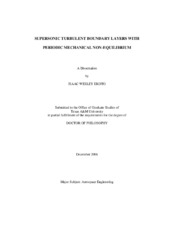| dc.contributor.advisor | Bowersox, Rodney | |
| dc.creator | Ekoto, Isaac Wesley | |
| dc.date.accessioned | 2007-04-25T20:03:42Z | |
| dc.date.available | 2007-04-25T20:03:42Z | |
| dc.date.created | 2006-12 | |
| dc.date.issued | 2007-04-25 | |
| dc.identifier.uri | https://hdl.handle.net/1969.1/4709 | |
| dc.description.abstract | Previous studies have shown that favorable pressure gradients reduce the
turbulence levels and length scales in supersonic flow. Wall roughness has been shown to
reduce the large-scales in wall bounded flow. Based on these previous observations new
questions have been raised. The fundamental questions this dissertation addressed are: (1)
What are the effects of wall topology with sharp versus blunt leading edges? and (2) Is it
possible that a further reduction of turbulent scales can occur if surface roughness and
favorable pressure gradients are combined? To answer these questions and to enhance the
current experimental database, an experimental analysis was performed to provide high
fidelity documentation of the mean and turbulent flow properties along with surface and
flow visualizations of a high-speed ( 2.86 M = ), high Reynolds number (Re 60,000 q » )
supersonic turbulent boundary layer distorted by curvature-induced favorable pressure
gradients and large-scale ( 300 s k + » ) uniform surface roughness. Nine models were tested
at three separate locations. Three pressure gradient models strengths (a nominally zero, a
weak, and a strong favorable pressure gradient) and three roughness topologies
(aerodynamically smooth, square, and diamond shaped roughness elements) were used.
Highly resolved planar measurements of mean and fluctuating velocity components were
accomplished using particle image velocimetry. Stagnation pressure profiles were acquired with a traversing Pitot probe. Surface pressure distributions were characterized
using pressure sensitive paint. Finally flow visualization was accomplished using
schlieren photographs.
Roughness topology had a significant effect on the boundary layer mean and
turbulent properties due to shock boundary layer interactions. Favorable pressure
gradients had the expected stabilizing effect on turbulent properties, but the
improvements were less significant for models with surface roughness near the wall due
to increased tendency towards flow separation. It was documented that proper roughness
selection coupled with a sufficiently strong favorable pressure gradient produced regions
of “negative†production in the transport of turbulent stress. This led to localized areas of
significant turbulence stress reduction. With proper roughness selection and sufficient
favorable pressure gradient strength, it is believed that localized relaminarization of the
boundary layer is possible. | en |
| dc.format.extent | 28353497 bytes | en |
| dc.format.medium | electronic | en |
| dc.format.mimetype | application/pdf | |
| dc.language.iso | en_US | |
| dc.publisher | Texas A&M University | |
| dc.subject | supersonic | en |
| dc.subject | turbulent | en |
| dc.subject | boundary layer | en |
| dc.subject | roughness | en |
| dc.subject | favorable pressure gradient | en |
| dc.title | Supersonic turbulent boundary layers with periodic mechanical non-equilibrium | en |
| dc.type | Book | en |
| dc.type | Thesis | en |
| thesis.degree.department | Aerospace Engineering | en |
| thesis.degree.discipline | Aerospace Engineering | en |
| thesis.degree.grantor | Texas A&M University | en |
| thesis.degree.name | Doctor of Philosophy | en |
| thesis.degree.level | Doctoral | en |
| dc.contributor.committeeMember | Girimaji, Sharath | |
| dc.contributor.committeeMember | North, Simon | |
| dc.contributor.committeeMember | Rediniotis, Othon | |
| dc.type.genre | Electronic Dissertation | en |
| dc.type.material | text | en |
| dc.format.digitalOrigin | born digital | en |


